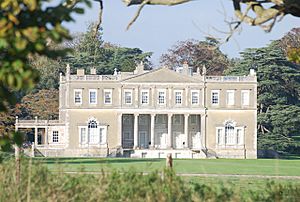Crichel House facts for kids
Crichel House is a large, historic country house located near the village of Moor Crichel in Dorset, England. It's considered a very important building, listed as Grade I listed because of its special architecture. The house has a beautiful entrance designed by Thomas Hopper and amazing rooms inside created by James Wyatt. It sits in a huge park that is about 400 acres (162 hectares) big. This park includes a large, curved lake that covers 50 acres (20 hectares). The park itself is also listed as a Grade II historic site.
History of Crichel House
The first house on this spot was built in the Tudor style and belonged to the Napier family. Sadly, much of it was destroyed in a fire in 1742. It was then rebuilt in a grand English Baroque style for Sir William Napier.
Later, in 1765, Humphrey Sturt took over the estate. He worked with the Bastard family to make big changes to the house between 1771 and 1773. They made it larger and added a fancy Ionic porch to the front. The inside rooms were redesigned by James Wyatt and decorated with paintings by Biagio Rebecca. The park around the house was also changed to look like the famous designs by Capability Brown, with the curved lake and groups of trees.
After Humphrey Sturt passed away in 1786, his son Charles inherited Crichel. Later, Charles's son, Henry Charles Sturt, asked Thomas Hopper to design a new entrance hall on the west side of the house in 1831.
Even more changes were made by Henry Charles's son, Henry Gerard Sturt, who became the first Baron Alington in 1876. He hired William Burn to give the outside of the house a more neoclassical look. They also added a special covered entrance for carriages called a porte-cochère. New sections were built on the north side for the family and servants.
Starting in 1905, the house was updated again by Henry Sturt's son, Humphrey Napier Sturt, and his wife. Their son, Napier Sturt, 3rd Baron Alington, continued these changes in the late 1920s. They made the outside look more like the original Georgian style. A beautiful Italian garden was also designed by Harold Peto.
In 1938, during World War II, the Crichel estate was taken over by the Air Ministry for training purposes. The furniture was removed from the house. After the war, in 1946, the house was rented out to Cranborne Chase School, a boarding school for girls.
The 3rd Baron Alington died during the war, and his daughter, Mary Anna, inherited the estate when she was only 11. After she married Toby Marten, they became famous for the Crichel Down Affair. This was a big fight with the government, and in 1954, they won the right to buy back land that the government had taken from their family.
Mary Anna Marten ended the school's lease in 1961 so she could live in Crichel House herself. The house was then carefully restored. Some of the Victorian parts were removed, and the main rooms were redecorated. Features from the old Italian garden were used to create a new sunken courtyard. More changes were made inside in 1979–80, including bringing back a long gallery room that had been divided up.
Mary Anna Marten passed away in 2010. In 2013, her son, Napier Marten, sold Crichel House and some of the land to an American billionaire named Richard Chilton. Mr. Chilton has been working to restore the house, bringing back many of James Wyatt's original designs and adding new furnishings.
Crichel Down Estate and Village
When the parkland for Humphrey Sturt was being designed, the village of Moor Crichel had to be moved about a mile south to make space for the large lake. Many villagers moved to a place called Witchampton. The old parish church of St Mary's, built in 1850, is still there near the lake. It is also a Grade II* listed building.
When Mary Anna Marten died, the Crichel Down estate was very large, covering about 7,932 acres (3,210 hectares). It included four villages, St. Mary's church, a school, and a cricket club. This large estate was left to Napier Marten and his five sisters. Today, parts of the estate are owned by different companies. Sometimes, the beautiful gardens are opened to the public through the National Garden Scheme.
Notable Visitors to Crichel House
Crichel House has hosted some very important guests over the years. George IV stayed there when he was still a prince, known as the Prince Regent. His daughter, Princess Charlotte Augusta of Wales, also spent time at Crichel House when she was young.



